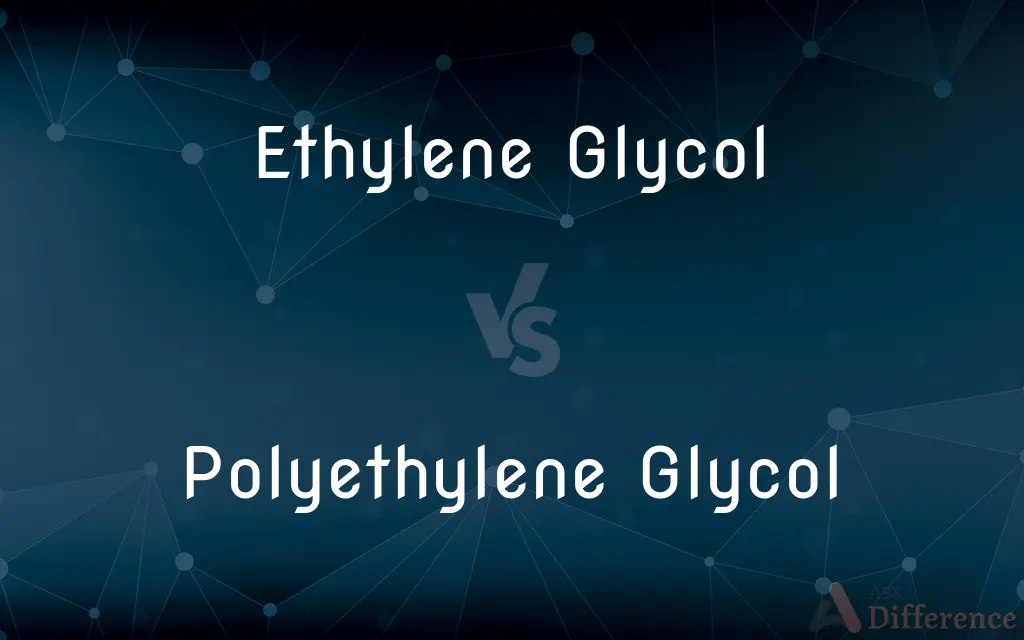Ethylene Glycol vs. Polyethylene Glycol — What's the Difference?
By Tayyaba Rehman — Published on November 12, 2023
Ethylene Glycol is a small organic compound often used as an antifreeze, while Polyethylene Glycol is a polymer derived from Ethylene Glycol and is utilized in various medical and industrial applications.

Difference Between Ethylene Glycol and Polyethylene Glycol
Table of Contents
ADVERTISEMENT
Key Differences
Ethylene Glycol is a simple diol compound with the formula C2H6O2. This colorless, odorless, and sweet-tasting liquid is best known for its use as an antifreeze in automobiles and as a precursor in the manufacture of polymers. Its ability to lower the freezing point of water while elevating its boiling point makes Ethylene Glycol an essential component in cooling systems.
Polyethylene Glycol, often abbreviated as PEG, is a polymer derived from Ethylene Glycol. Its structure is a repetition of –O-CH2-CH2- units. Polyethylene Glycol comes in various molecular weights, influencing its viscosity, solubility, and other physical properties. Its applications are diverse, ranging from its role as a laxative in medicine to its use in cosmetics, as a surfactant, and as a base in numerous pharmaceutical formulations.
While Ethylene Glycol is primarily recognized for its antifreeze properties, Polyethylene Glycol's fame stems from its versatility in different fields due to its adjustable molecular weights and characteristics. Despite both being derived from ethylene, their applications, structures, and functionalities differ considerably.
One crucial distinction to note is the toxicity of Ethylene Glycol, which can be poisonous if ingested. It's metabolized in the body to toxic compounds, posing risks of kidney damage and central nervous system depression. On the other hand, Polyethylene Glycol is generally recognized as safe and is even an ingredient in some medications and personal care products.
In essence, while Ethylene Glycol and Polyethylene Glycol share a foundational element and have overlapping roles in the polymer industry, their differences in structure, application, and safety profile mark them as distinct entities in the realms of chemistry and industry.
ADVERTISEMENT
Comparison Chart
Chemical Structure
Simple diol with formula C2H6O2.
Polymer with repeating –O-CH2-CH2- units.
Primary Use
Antifreeze in automobiles.
Medicinal, cosmetic, and industrial applications.
Toxicity
Toxic if ingested.
Generally recognized as safe for many applications.
Molecular Weight
Fixed, low molecular weight.
Varies; can be adjusted to obtain desired properties.
Physical State
Liquid at room temperature.
State varies (liquid, gel, solid) based on molecular weight and concentration.
Compare with Definitions
Ethylene Glycol
Simple diol with the formula C2H6O2.
Ethylene Glycol's ability to lower the freezing point makes it useful as an antifreeze.
Polyethylene Glycol
Generally recognized as safe for many uses.
Unlike its precursor, Polyethylene Glycol is non-toxic in most applications.
Ethylene Glycol
Primary ingredient in automotive antifreeze.
Cars use Ethylene Glycol-based coolants to prevent engine overheating.
Polyethylene Glycol
Polymer derived from Ethylene Glycol.
Polyethylene Glycol's diverse molecular weights allow varied applications.
Ethylene Glycol
A colorless, odorless, sweet-tasting liquid.
Due to its sweet taste, Ethylene Glycol poses a poisoning risk if accidentally consumed.
Polyethylene Glycol
Adjustable molecular weight polymer.
The properties of Polyethylene Glycol can be tailored for specific needs.
Ethylene Glycol
Precursor in polymer production.
Ethylene Glycol is a starting material in manufacturing PET plastics.
Polyethylene Glycol
Component in cosmetics and pharmaceuticals.
Many skin creams contain Polyethylene Glycol as a moisturizing agent.
Ethylene Glycol
Toxic when ingested.
Consuming Ethylene Glycol can lead to severe medical complications.
Polyethylene Glycol
Used as a laxative in medicine.
Polyethylene Glycol is an active ingredient in some over-the-counter constipation remedies.
Common Curiosities
Is Ethylene Glycol safe for consumption?
No, Ethylene Glycol is toxic and can be harmful if ingested.
Can Polyethylene Glycol be found in cosmetics?
Yes, Polyethylene Glycol is often used in cosmetics due to its moisturizing properties.
What is Ethylene Glycol?
Ethylene Glycol is a simple diol used predominantly as an antifreeze.
How does the structure of Polyethylene Glycol vary?
Polyethylene Glycol's structure varies based on its molecular weight, which can be adjusted for specific applications.
What is the primary use of Ethylene Glycol?
Its primary use is as an antifreeze in automobile cooling systems.
How does Polyethylene Glycol differ from Ethylene Glycol?
Polyethylene Glycol is a polymer derived from Ethylene Glycol and has diverse applications in medicine, cosmetics, and industry.
Why is Polyethylene Glycol used in medicines?
Due to its properties and safety profile, Polyethylene Glycol acts as a laxative and is present in various pharmaceutical formulations.
Are there medical applications for Ethylene Glycol?
No, due to its toxicity, Ethylene Glycol is not used in medicine.
How does Ethylene Glycol affect the environment?
If not properly disposed of, it can contaminate water sources, posing risks to aquatic life.
What are the dangers of Ethylene Glycol ingestion?
It's toxic and can lead to kidney damage, CNS depression, and even death.
Is Polyethylene Glycol derived from Ethylene Glycol?
Yes, Polyethylene Glycol is a polymer derived from Ethylene Glycol.
Can Polyethylene Glycol's properties be tailored?
Yes, by adjusting its molecular weight, its properties can be tailored for specific needs.
Do Polyethylene Glycol and Ethylene Glycol have the same safety profile?
No, while Ethylene Glycol is toxic, Polyethylene Glycol is generally recognized as safe for many applications.
Why is Ethylene Glycol used in antifreeze?
Ethylene Glycol can lower the freezing point of water, making it ideal for antifreeze.
Is Polyethylene Glycol safe for skin application?
Generally, it's safe and is found in many skincare products.
Share Your Discovery

Previous Comparison
File System vs. DBMS
Next Comparison
Voicemail vs. Voice MailAuthor Spotlight
Written by
Tayyaba RehmanTayyaba Rehman is a distinguished writer, currently serving as a primary contributor to askdifference.com. As a researcher in semantics and etymology, Tayyaba's passion for the complexity of languages and their distinctions has found a perfect home on the platform. Tayyaba delves into the intricacies of language, distinguishing between commonly confused words and phrases, thereby providing clarity for readers worldwide.













































